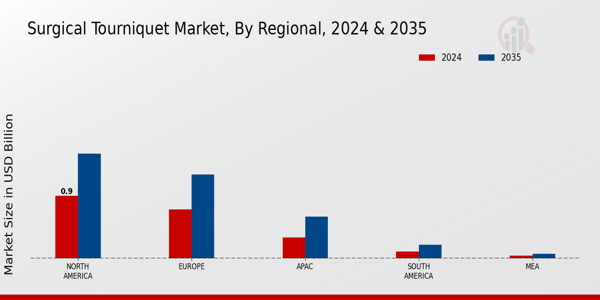Rising Surgical Procedures
The Surgical Tourniquet Market is witnessing growth driven by the increasing number of surgical procedures performed annually. Factors such as an aging population and the prevalence of chronic diseases are contributing to a higher demand for surgical interventions. Recent statistics indicate that elective surgeries are on the rise, with estimates suggesting that the number of surgeries could increase by 10% over the next five years. This surge in surgical activity necessitates the use of reliable and efficient tourniquet systems to manage blood flow during operations. Consequently, manufacturers are focusing on developing advanced tourniquet solutions that cater to the growing needs of healthcare providers, thereby expanding their market presence.
Increased Focus on Patient Safety
In the Surgical Tourniquet Market, there is an increasing emphasis on patient safety, which is driving market growth. Healthcare providers are prioritizing the implementation of safety protocols to minimize risks during surgical procedures. This focus is reflected in the rising adoption of tourniquets that feature safety mechanisms, such as automatic pressure release and alarms for pressure monitoring. According to recent data, hospitals that have adopted advanced tourniquet systems report a decrease in adverse events related to limb ischemia. This heightened awareness of patient safety is likely to propel the demand for innovative surgical tourniquets, as healthcare facilities strive to enhance their surgical practices and ensure better patient outcomes.
Regulatory Compliance and Standards
The Surgical Tourniquet Market is significantly influenced by stringent regulatory compliance and standards set by health authorities. These regulations ensure that surgical devices meet safety and efficacy requirements, which is crucial for patient care. Manufacturers are compelled to adhere to these guidelines, leading to the development of high-quality tourniquet systems that comply with international standards. The emphasis on regulatory compliance not only enhances product reliability but also fosters consumer trust in surgical devices. As healthcare facilities increasingly seek compliant products, the demand for certified surgical tourniquets is expected to rise, thereby driving market growth. This trend underscores the importance of maintaining high standards in the surgical device industry.
Growing Awareness and Training Programs
The Surgical Tourniquet Market is benefiting from growing awareness and training programs aimed at healthcare professionals. Educational initiatives focused on the proper use of surgical tourniquets are becoming more prevalent, which is essential for minimizing complications during surgeries. These programs emphasize the importance of understanding tourniquet application techniques and the potential risks associated with improper use. As healthcare providers become more knowledgeable, the demand for high-quality tourniquet systems is likely to increase. Furthermore, hospitals are investing in training sessions to ensure that their surgical teams are well-equipped to utilize these devices effectively. This trend is expected to contribute positively to the overall growth of the surgical tourniquet market.
Technological Advancements in Surgical Tourniquet Market
The Surgical Tourniquet Market is experiencing a notable transformation due to rapid technological advancements. Innovations such as automated tourniquet systems and digital monitoring devices are enhancing the efficiency and safety of surgical procedures. These advancements not only streamline operations but also reduce the risk of complications associated with traditional methods. For instance, the integration of smart technology allows for real-time monitoring of pressure levels, which is crucial in preventing tissue damage. As a result, the demand for advanced surgical tourniquets is projected to grow, with estimates suggesting a compound annual growth rate of over 5% in the coming years. This trend indicates a shift towards more sophisticated surgical tools that prioritize patient outcomes and operational efficiency.


















Leave a Comment